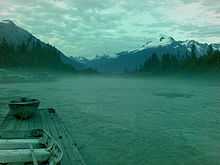Homathko River

The Homathko River is one of the major rivers of the southern Coast Mountains of British Columbia, and one of the few rivers that penetrates the range from the Chilcotin Plateau to the coastal inlets, entering the sea at the head of Bute Inlet adjacent to the mouth of the Southgate River, just to its east.
The Homathko's drainage basin is 5,335 square kilometres (2,060 sq mi) in size.[1]
The mountains flanking the Homathko River are the highest in the Coast Mountains, and include Mount Waddington west of the river in the Waddington Range and Mount Queen Bess east of the river, adjacent to the Homathko Icefield. Also flanking the Homathko River on the west are the Niut Range, which is in the angle of the Homathko and its main west fork, Mosley Creek, and the Whitemantle Range, which is to the south of the Waddington Range massif, forming the mountainous ridge dividing Bute and Knight Inlets. The Pantheon Range lies west of Mosley Creek and the Niut Range and adjoins the Waddington Range immediately on the north.
The Homathko begins in the northern part of the Niut Range, then descends to the Chilcotin Plateau, skirting it briefly near Tatla Lake, then turns south to Tatlayoko Lake and from there pierces the Pacific Ranges en route to the sea at the head of Bute Inlet.
The Homathko River Valley is one of the most difficult to navigate. The frigid waters make crossing impossible and the valley itself is lined with devil's club. It is also home to many grizzly bears.
History
Just below the confluence of Mosley Creek and the Homathko River, at the southern foot of the Niut Range, the bullying of a party of Tsilhqot'in First Nations warriors hired to help build an enterprise known as Waddington's Road led to their massacre of the road company's workers and the opening of hostilities between a faction of the Chilcotin people and the colonial government of British Columbia.
This was the opening round of the Chilcotin War of 1864. The land-surveyed townsite of Port Waddington on today's maps is a relic of those times. the townsite had been surveyed as part of roadbuilder Alfred Waddington's obligations in having the licence to build the road, as well as profit from the sale of lots (and some lots were sold, but the townsite never came to anything).
The route of the failed road contract was later considered for the mainline of the Canadian Pacific Railway, to connect to Vancouver Island via Seymour Narrows, connecting to Victoria, but Burrard Inlet was chosen for the railway's terminus-port city instead, thereby creating the City of Vancouver.
Hydroelectric Proposals
Attention to the route's possibilities waned since being eyed by the CPR but plans to develop the Homathko and its neighbouring rivers for hydroelectric power. The Homathko alone has immense hydroelectric potential, but full build-out as first conceived would divert the Taseko Lakes and Chilko Lake into the Homathko system via Tatlayoko Lake. A series of dams on the Homathko and its tributaries, using the extra power of the water from the Chilcotin's tributaries, would have generated some of the most power per project in British Columbia.
The creation of Ts'il?os Provincial Park (the '?' represents a glottal stop) and Big Creek Provincial Park have shelved the grand plan, as Chilko and Taseko Lakes are protected and cannot be diverted (also for salmon fishery reasons). But the dams proposed for the Homathko Canyon are still on the books and are effectively on sale by the export subsidiary of BC Hydro, Powerex. If ever built, the largest dam and powerhouse will stand at a point in the Homathko Canyon that is marked on the map as "Murderer's Bar" - no less than the spot on which the Chilcotin War began.
See also
- Homathko Estuary Provincial Park
- Waddington Canyon
- Great Canyon (Homathko River)
- Homathko River-Tatlayoko Protected Area
References
- ↑ Gazetteer of Canada. British Columbia. Canadian Board on Geographic Names. 1953. p. xv.
Coordinates: 50°55′52″N 124°51′37″W / 50.93111°N 124.86028°W